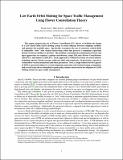Low Earth Orbit Slotting for Space Traffic Management Using Flower Constellation Theory
Author(s)
Arnas, David; Lifson, Miles; Linares, Richard; Avenda, Martin
DownloadAccepted version (673.2Kb)
Open Access Policy
Open Access Policy
Creative Commons Attribution-Noncommercial-Share Alike
Terms of use
Metadata
Show full item recordAbstract
This paper proposes the use of Flower Constellation (FC) theory to facilitate the design of a Low Earth Orbit (LEO) slotting system to avoid collisions between compliant satellites and optimize the available space. Specifically, it proposes the use of concentric orbital shells of admissible “slots” with stacked intersecting orbits that preserve a minimum separation distance between satellites at all times. The problem is formulated in mathematical terms and three approaches are explored: random constellations, single 2D Lattice Flower Constellations (2D-LFCs), and unions of 2D-LFCs. Each approach is evaluated in terms of several metrics including capacity, Earth coverage, orbits per shell, and symmetries. In particular, capacity is evaluated for various inclinations and other parameters. Next, a rough estimate for the capacity of LEO is generated subject to certain minimum separation and station-keeping assumptions and several trade-offs are identified to guide policy-makers interested in the adoption of a LEO slotting scheme for space traffic management.
Date issued
2020-01Department
Massachusetts Institute of Technology. Department of Aeronautics and AstronauticsJournal
AIAA Scitech 2020 Forum
Publisher
American Institute of Aeronautics and Astronautics (AIAA)
Citation
Arnas, David, Lifson, Miles, Linares, Richard and Avenda, Martin. 2020. "Low Earth Orbit Slotting for Space Traffic Management Using Flower Constellation Theory." AIAA Scitech 2020 Forum, 1 PartF.
Version: Author's final manuscript